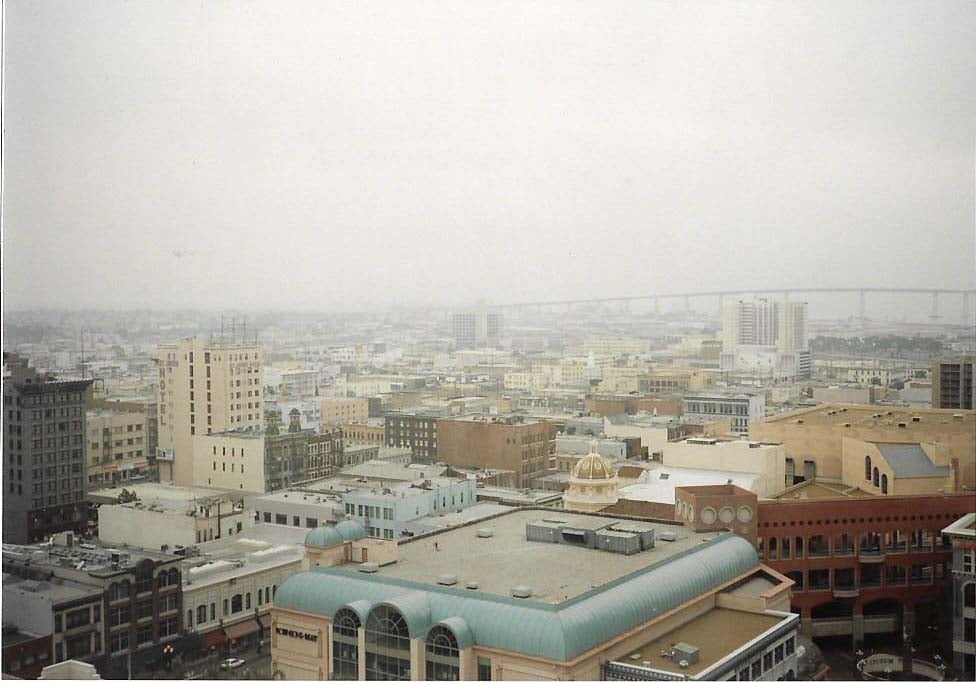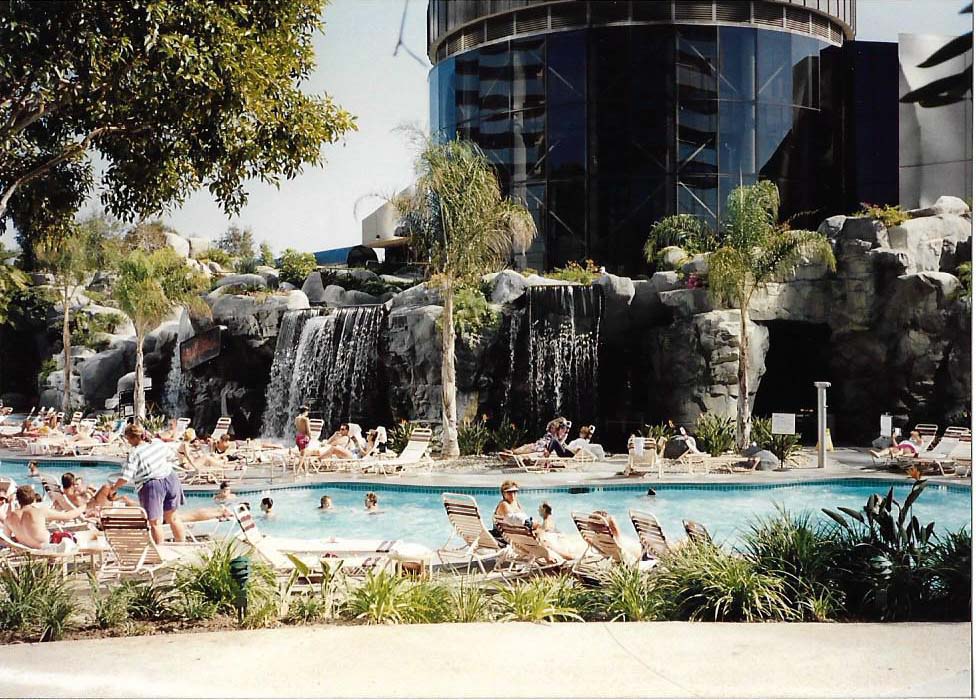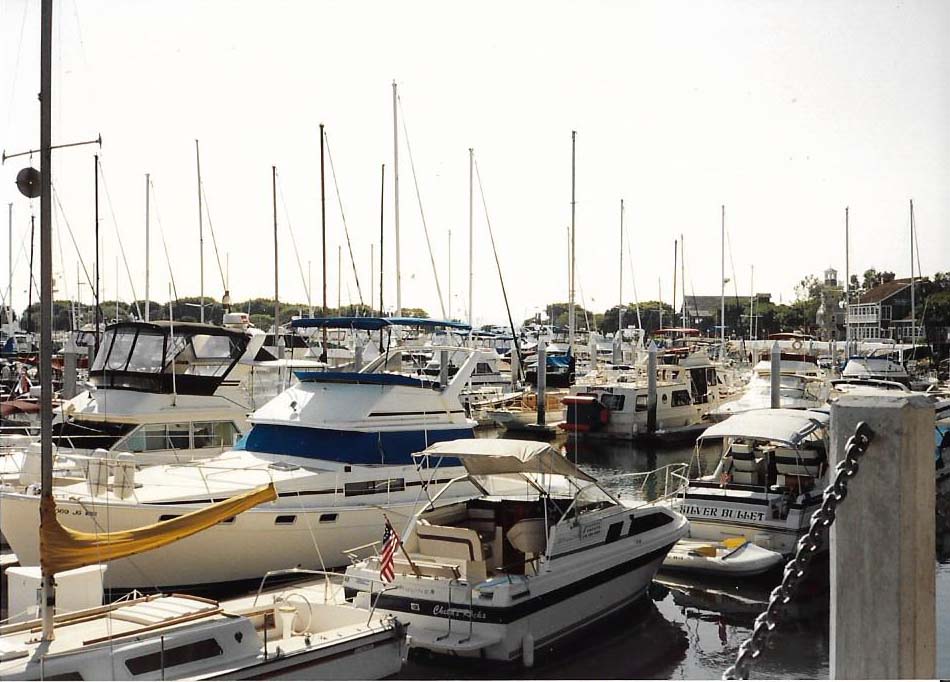My one and only San Diego Comicon

The author at the '94 San Diego Comicon. Image courtesy of Lurene Haines
In the summer of 1994 I participated in the San Diego Comicon as a guest. It was to be my first and last visit.
My credentials hardly qualified me as a “guest.” I went there largely on the coattails of cover artist Dave Dorman and his then-wife, Lurene Haines. I’d known Dave and Lurene since the early ‘90s; Lurene joined our science fiction-horror writers group, which at the time consisted of me, my friend Ray Aldridge, Ed Sears and his daughter Vicki, and Richard Bamberg. We usually met at a local saloon named Chan’s, which sat on the limb of a tranquil bayou. Our meetings were anything but tranquil. Fueled by too much beer, we raucously critiqued each other’s work, and usually extended the meeting to a nearby poolhall, Starcade. Sometimes Dave would join us. That’s how we met.
Lurene was constantly encouraging us to try our hands at scripting comic books. As a kid I’d read comics – in Spain, where there was no TV and precious little radio. We had no other option … well, I suppose I could’ve read a book, but c’mon! I was 6 years old. But as I grew older and passed through my TV-watching stage, I turned to books, and as I began writing my own stories it was in the narrative style of novels and short stories, not the scripted style of comics.
Still, when Lurene told us about the money to be made, I was tempted – especially when she floated a possible project with Marvel Comics. Seems their Epic imprint was looking for scripts for Clive Barker’s “Hellraiser” series. I’d read Barker’s “Books of Blood” and “The Hellbound Heart” upon which “Hellraiser” was based, and I knew the basic premise – successfully manipulate the Lament Configuration (and you could do so only if you were deservingly evil) and a lifetime of torment followed.







I sat down and wrote my first script, modeled on the style of a script Dave and Lurene loaned me. When I was done I gave it to Lurene, who submitted it with a script she had written for “Hellraiser” editor Dan Chichester. A few weeks later, voila! Both were accepted and suddenly I was a comic book writer. About the same time I sold my first short story to a professional publisher, Bantam-Spectra’s “Full Spectrum” anthology series. Now I as a dual-track writer – comics and prose.
A year or so later I was commiserating with Dave and Lurene about my future as a writer, and how I’d like to do the job full-time. They’d been encouraging me to take on more work in comics, and they wanted me to start going with them to conventions. I knew from experience that if you wanted writing jobs you had to attend conventions – that’s where you meet editors, make impressions, and get future jobs. It’s also where you learn about future projects that aren’t advertised to the public body of writers. That was one of my greatest frustrations as a beginning writer – it seemed a vast body of markets existed just beyond my reach, simply because I didn’t know about them, or hadn’t been invited to submit. And that was because none of these editors knew I existed. I didn’t attend conventions.
So I sat down with Dave and Lurene one afternoon and basically said “Yes, I’ll go to conventions with you. I want to get into comics.” Hence, my departure for San Diego one summer morning in 1994.
I really didn’t know how lucky I was – to have an entre to the professional world of comic book publishing at the hands of Dave Dorman, one of the greatest cover artists of our time … he opened far more doors for me than I deserved. I’ve never had a good opinion of myself as a writer. Bottom line? I’m not really very smart. Most writers I know are smart people who can not only come up with a story idea but conceive it both artistically and mechanically, something that was impossible for me to do. My approach was to jump in, see what worked, and rewrite – not the most efficient process. And if you asked what I was attempting to “say” with a particular work I likely couldn’t tell you. I just didn’t know. I didn’t know because I wasn’t very smart.
But I did know comic book artists were perhaps not the best storytellers – visually, yes. But plot-wise? Maybe not. Some were. But based on what I was seeing in contemporary comics, the stories to a large extent seemed thin, the artwork overpowering. So maybe there was a place in comics for a prose writer, even a lame, half-assed prose writer like myself.
You may remember in the late ’80s through the mid-’90s comics enjoyed a renaissance thanks to the collectibles market. We were part of that boom. There was good money to be made – excellent money – if you could get the work. And Dave was getting the work, so much he couldn’t keep up with it all. This was prior to the wave of comics-to-movies but you could see that coming down the road as science fiction, fantasy and horror inserted themselves into the popular entertainment medium. It really did look like the sky was the limit.
In 1994 Comicon was not the gigantic multi-media con it is today. Mostly it concentrated on comics and graphic novels. You did see the occasional celebrity but nothing like the extravaganza that just played out in San Diego.
Here are my impressions:
The flight to San Diego: I could never become a habitue of the convention circuit because I hate flying, and most of the big cons are located across country. Comicon is in San Diego. Chicago hosts another big comic convention. The World Fantasy, World Horror and World Science Fiction conventions travel around the country.
I remember the flight from Pensacola to San Diego as an endurance test of counting the minutes. In fact, it inspired me to write a short story, “The Fear of Fear Itself,” which was published in the Pocket Books anthology “More Phobias.”
As we were on final approach to San Diego International Airport, Lurene said, “Hey Del, look out the window.” I did, and all I could see were buildings – we were flying between skyscrapers! The airport sits in the middle of town, right on the water, and sometimes the approach takes you through buildings on the hills around the harbor. It was very scary for somebody who doesn’t like to fly.
The airport: I was astonished at how small the airport was. Space is at a premium in San Diego, and the tiny airport is a product of that confined area. Our plane didn’t even park next to a skyramp – we climbed down stairs and walked across the tarmac to the terminal, which was very dark and somewhat run-down. As I looked back to the airplane I saw a fluid dripping from one of the engines. Thank God I hadn’t seen that before we took off.
San Diego itself: Because of its small area for such a large city, San Diego is very tightly and efficiently laid out. It’s got lots of restaurants, hotels and shopping areas, including a very neat vertical shopping center, Horton Plaza, that lay within walking distance of the Westin San Diego, where we were staying.
Jogging with a DC editor: Every morning Lurene and I arose before sunup and went jogging with an editor from DC. I believe it was John Nee though I may be mistaken. He set a “brisk pace,” which is to say I was nearly exhausted by the time we finished. I remember talking with him in the hotel lobby one morning. I turned the subject to comic books and he very quickly said, “That’s work. Let’s not talk about work.” I learned at that moment many editors attend conventions to socialize, not network per se, and that knowledge served me well over the coming years.
The Convention Center: The San Diego Convention Center epitomizes what convention centers should be about. It’s a large, modern structure, right on the water, and becomes the focal point of the hotel, restaurant and shopping district. I also remember it being very hot inside – you cram 10,000 fanboys-girls into a confined space with multi-media platforms running at virtually every booth and you get some serious heat. I remember sweating the entire time I was there. I remember when I was there peeking behind a curtain at a Ford display of the new model Mustang. Interesting!
The fans: Even in 1994 the convention was packed! You could barely navigate the walkways and it was difficult to approach a booth. Many fans were dressed in costumes, which is not unusual. I’d attended enough conventions to become inured to that reality. Many of the costumes I couldn’t identify – I simply wasn’t that familiar with comics.
Kij Johnson: I met one other prose writer there, Kij Johnson. We were so relieved to run into one another. We chatted for a few minutes then went our separate ways, but it was nice to encounter a kindred soul of prose.
The celebrities: I encountered only two celebrities while I was there, Clive Barker and John Ritter. Barker was making his way through a crowd and I didn’t get to speak to him. You’ll laugh when I saw this, but I thought he’d be taller. Ritter was standing in the Westin parking garage with a passel of kids, waiting for his car to be brought to him by the valet. I didn’t get a chance to talk to him either.
The convention: I say this for the sake of honesty: I felt like a fish out of water. I was unfamiliar with the comic book monde and I knew none of these people. Lurene was pressuring me to “do business” and I’m sure any “business” I did was counterproductive as there was no way to disguise my ignorance. The extent of my comic book work consisted of one “Hellraiser” story and a novella titled “Roadkill,” published by Caliber. Consequently, nobody knew who I was either and they were not willing to waste time on an unknown quantity like yours truly. So I spent the first two days wandering the convention hall, picking up as many business cards as I could and talking to whomever would listen to me. It didn’t seem my time there was very productive yet I was spending a small fortune on plane fare, the hotel, and eating at pricey restaurants. So finally on Day 3 I said to hell with it and spent the day at Horton Plaza, shopping. I was exhausted and more than a little depressed. It seemed I had no place there and wouldn’t have until I’d educated myself about the world of comics, and published a few more projects. I spent one more day at the convention, basically accomplishing nothing, and thankfully we left the next day.
The ride back: The flight out of San Diego was turbulent. By this time Lurene had assumed the role of official Calmer of Del on the Plane Flight and spent the first 30 minutes assuring me these bumps and bounces were perfectly normal. My God, I couldn’t think of anything more awful than being trapped in a metal tube five miles above the ground with nowhere to go and nothing to do if anything went wrong. When we arrived in Pensacola that night I dropped to my knees in the parking lot and kissed the ground. It was the end of our convention travels for the year. I think they got a picture of that.
Shortly thereafter I suffered a kind of existential overload and temporarily called an end to my convention travels. Work was overwhelming, I was experiencing a great deal of turmoil in my personal life, and I was not happy with my writing life. Dave was getting me tons of work, but over time I began to realize that while my ego and my bank account liked comics, my heart belonged to prose. But all was not well in the prose world either. I was receiving invitations to themed anthologies, but found myself balking at the write-a-story-to-fit-the-premise requirement. Worse, I had just gotten access to the Internet and found myself wondering if the web would allow time in anyone’s day to read a book, and if reading itself would fall out of fashion. The prospects for a barely competent writer like myself making a living of novels seemed daunting at best.
Toward the end of the ’90s and into the 2000s, I found myself writing less. I was constantly distracted by online stuff, and the idea of sitting behind the computer for hours on end, doing something that was similar to what I did at work all day, struck me as unfathomable. I did manage to finish a novella which became a finalist for the British Fantasy Award, and I took a great deal of pride in that (although it was savaged by British critics). I managed to publish a short story here and there. But it seemed the momentum was lost. Today, I wouldn’t even know how to go about submitting a written work to a publication, and I know nothing about the self-publishing industry. Seeing as how that’s where books like “Twilight” and “Fifty Shades of Gray” came from, perhaps I should.
I always be indebted to Dave and Lurene for trying to help me.
But I don’t think I’ll be attending any more Comicons.
About the author:
Del Stone Jr. is a professional fiction writer. He is known primarily for his work in the contemporary dark fiction field, but has also published science fiction and contemporary fantasy. Stone’s stories, poetry and scripts have appeared in publications such as Amazing Stories, Eldritch Tales, and Bantam-Spectra’s Full Spectrum. His short fiction has been published in The Year’s Best Horror Stories XXII; Alfred Hitchcock’s Mystery Magazine; the Pocket Books anthology More Phobias; the Barnes & Noble anthologies 100 Wicked Little Witch Stories, Horrors! 365 Scary Stories, and 100 Astounding Little Alien Stories; the HWA anthology Psychos; and other short fiction venues, like Blood Muse, Live Without a Net, Zombiesque and Sex Macabre. Stone’s comic book debut was in the Clive Barker series of books, Hellraiser, published by Marvel/Epic and reprinted in The Best of Hellraiser anthology. He has also published stories in Penthouse Comix, and worked with artist Dave Dorman on many projects, including the illustrated novella “Roadkill,” a short story for the Andrew Vachss anthology Underground from Dark Horse, an ashcan titled “December” for Hero Illustrated, and several of Dorman’s Wasted Lands novellas and comics, such as Rail from Image and “The Uninvited.” Stone’s novel, Dead Heat, won the 1996 International Horror Guild’s award for best first novel and was a runner-up for the Bram Stoker Award. Stone has also been a finalist for the IHG award for short fiction, the British Fantasy Award for best novella, and a semifinalist for the Nebula and Writers of the Future awards. His stories have appeared in anthologies that have won the Bram Stoker Award and the World Fantasy Award. Two of his works were optioned for film, the novella “Black Tide” and short story “Crisis Line.”
Stone recently retired after a 41-year career in journalism. He won numerous awards for his work, and in 1986 was named Florida’s best columnist in his circulation division by the Florida Society of Newspaper Editors. In 2001 he received an honorable mention from the National Lesbian and Gay Journalists Association for his essay “When Freedom of Speech Ends” and in 2003 he was voted Best of the Best in the category of columnists by Emerald Coast Magazine. He participated in book signings and awareness campaigns, and was a guest on local television and radio programs.
As an addendum, Stone is single, kills tomatoes and morning glories with ruthless efficiency, once tied the stem of a cocktail cherry in a knot with his tongue, and carries a permanent scar on his chest after having been shot with a paintball gun. He’s in his 60s as of this writing but doesn’t look a day over 94.
Contact Del at [email protected]. He is also on Facebook, twitter, Pinterest, tumblr, TikTok, and Instagram. Visit his website at delstonejr.com .